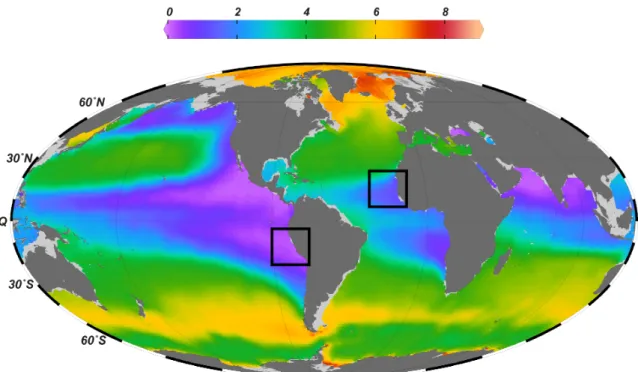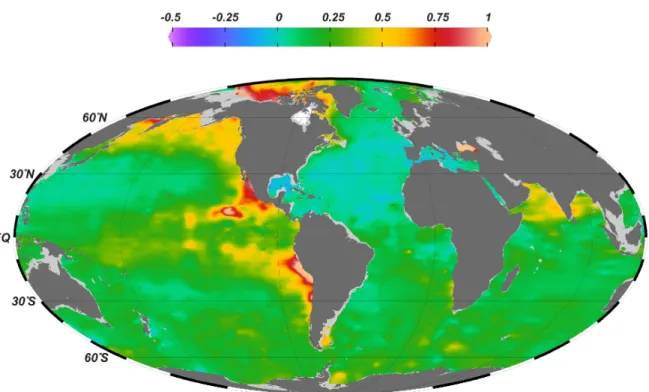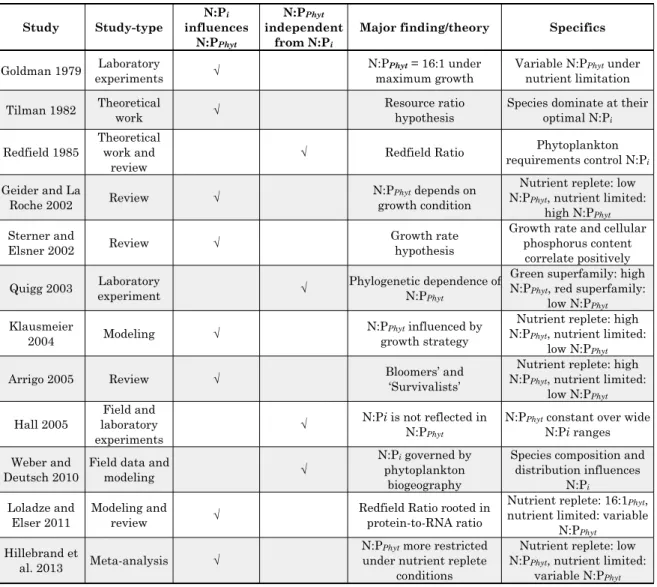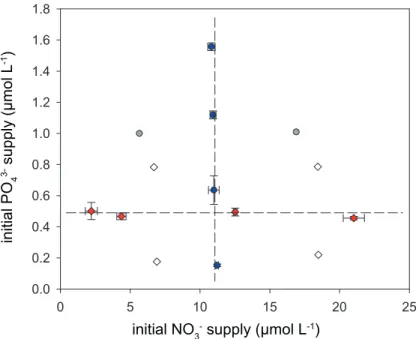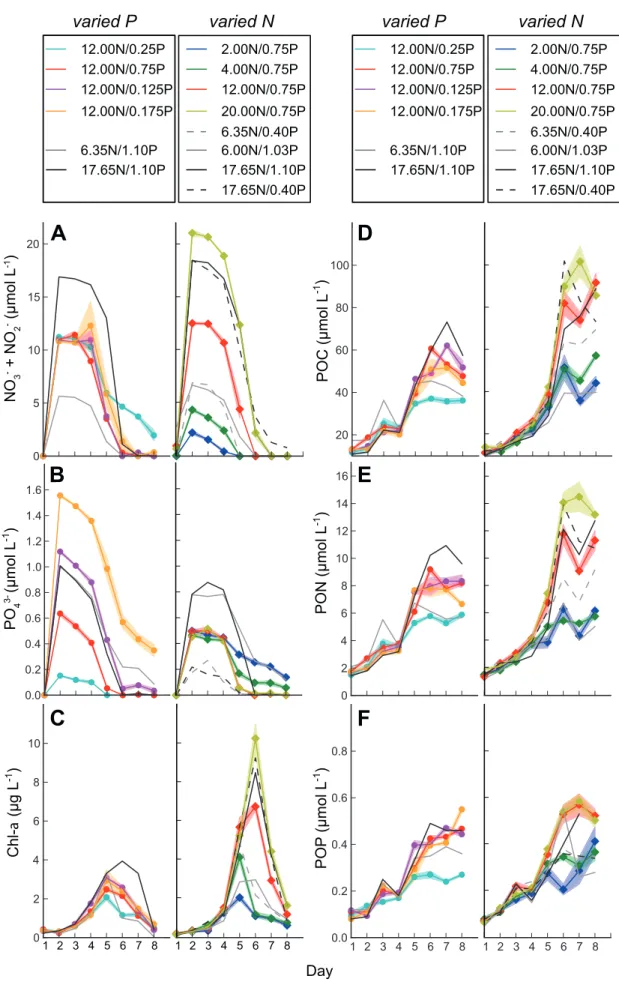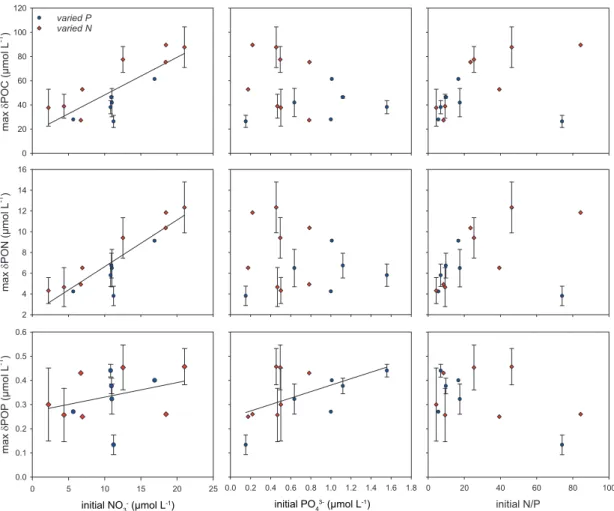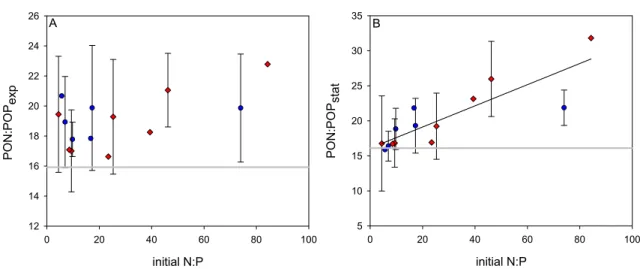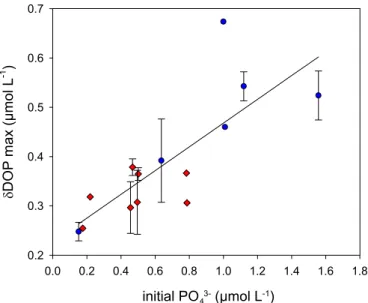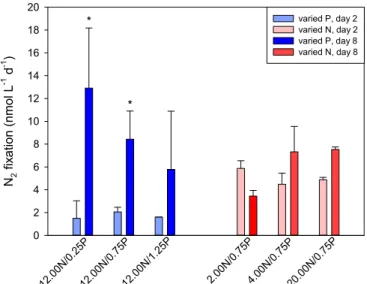Changes in nutrient stoichiometry:
phytoplankton & organic matter dynamics in coastal upwelling systems
Dissertation
vorgelegt von
Judith Meyer
zur Erlangung des akademischen Grades eines Doktors der Naturwissenschaften
- Dr. rer. nat. -
an der Mathematisch-Naturwissenschaftlichen Fakultät der Christian-Albrechts-Universität zu Kiel
Kiel, März 2016
Cover picture:
Diatoms, Klaus D. Kemp
1. Gutachter: Prof. Dr. Ulf Riebesell 2. Gutachter: Prof. Dr. Eric Achterberg Tag der Disputation: 26.05.2016
Zum Druck genehmigt: 26.05.2016
Contents
Summary VII
Zusammenfassung IX
General Introduction 13
...
Eastern boundary upwelling systems 13
...
Oxygen minimum zones 14
The effect of low O2 concentrations on nutrient cycling ...16 ...
Phytoplankton production and nutrient stoichiometry 19 ...
Nitrogen fixation and the diazotrophic niche in upwelling regions 22 ...
EBUS and climate change 24
Motivation and thesis outline 25
...
Open questions and major objectives 25
...
First-author papers and declaration of contribution 27 Chapter I: Changing nutrient stoichiometry affects phytoplankton
production, DOP accumulation and dinitrogen fixation – a mesocosm
experiment in the eastern tropical North Atlantic 41
Chapter II: The effect of nutrient stoichiometry on organic matter dynamics, phytoplankton community composition and diazotrophy in
the eastern tropical South Pacific 79
Chapter III: Dissolved phosphorus compounds enhance N2 fixation
rates in the eastern tropical North Atlantic 111
Synthesis and future perspectives 135
...
Controls on cellular nutrient stoichiometry 135
...
The influence of P* on DOP dynamics 138
N2 fixation in the vicinity of upwelling regions ...138 ...
Biogeochemical and ecological consequences of expanding OMZs 141 Methodological approaches: Combining experiments and
...
field studies 142
Future research perspectives 143
...
Characterization of the dissolved organic matter pool 144 ...
The role of diazotrophs in DON and DOP cycling 144 ...
Impacts on export production 145
Danksagung 153
Eidesstattliche Erklärung 155
Curriculum Vitae 157
Contents
V
Summary
Coastal upwelling systems associated to the eastern continental margins of the Atlantic and Pacific Oceans are among the most productive realms of the marine ecosystems. Although they only occupy a small area, they play a globally important role in the cycling of nitrogen (N), phosphorus (P) and other biologically relevant elements. In subsurface waters of upwelling systems, oxygen minimum zones (OMZs) persist as a result of biological degradation and sluggish ventilation. Reduced oxygen concentrations influence redox sensitive nutrient inventories by promoting N loss processes and P release from the sediment. Hence, water masses upwelled to the surface feature low N:P ratios that deviate from canonical Redfield proportions of 16:1. Due to the excess P over N, upwelling systems are thought to favor the growth of dinitrogen (N2) fixing organism (diazotrophs) that could potentially restore inorganic nutrient ratios back to Redfield proportions and replenish the N deficit in those waters. Contrary to this assumption, the presence of non- diazotrophic phytoplankton utilizing nutrients in lower than Redfield proportions has been suggested to eliminate the niche for diazotrophs. Thus, the dominance of either Redfield or non-Redfield primary production is thought to determine the amount of N fixed in upwelling systems.
In light of expanding OMZs and the predicted modification of nutrient inventories, this doctoral dissertation aimed to investigate the impact of changing N:P supply ratios on phytoplankton and organic matter composition.
Moreover, the potential of primary producers to modify nutrient supply anomalies and their role in coupling or decoupling sources and sinks of fixed N was assessed. To accomplish this, nutrient manipulation experiments and a field study were conducted in the eastern tropical North Atlantic (ETNA) and eastern tropical South Pacific (ETSP).
To better understand the impact of changing N:P ratios on primary production and on N2 fixation in the ETNA surface ocean, mesocosm experiments with natural plankton communities were carried out in the first study. Nutrient drawdown, bloom formation, biomass build-up and diazotrophic feedback mechanisms in response to variable N:P ratios were investigated. The obtained results indicate that N availability was the key factor determining primary production. Moreover, phytoplankton elemental composition depended on the organisms’ growth phase rather than on initial nutrient supply ratios. A channeling of excess P into the dissolved organic phosphorus (DOP) pool was
Summary
VII
observed in all experiments. Two findings strongly challenged the classical Redfield-based view on N2 fixation: (i) the availability of inorganic N compounds did not negatively affect N2 fixation and (ii) under P limitation, DOP seemed to provide an additional P source for diazotrophs.
In the second study, phytoplankton species distribution and organic matter composition was investigated during in situ measurements in the ETSP.
Results from this study demonstrated that low inorganic N:P ratios in the water column were not mirrored in particulate organic matter ratios, which was contrary to previous studies in this region. Drawdown of excess P and accumulation of DOP was indicative of the same mechanism of P channeling into the dissolved organic pool that was observed in the mesocosm experiments. The presence of previously undetected diazotrophic pigments in the highly productive shelf region further pointed towards the depletion of excess P or DOP through N2 fixation.
Motivated by the outcome of the first two studies, bioassay experiments were conducted in the third study to test the availability of selected organic and inorganic P sources to diazotrophs. The obtained results demonstrated that diazotrophs were able to sustain and increase N2 fixation rates on all tested P compounds, highlighting their competitive advantage under conditions of P depletion and DOP availability.
Results from this doctoral dissertation indicate that excess P is consumed and partially converted to DOP in upwelling regions. Transformation of excess P to DOP and its consumption by diazotrophs supports the assumption of a local replenishment of the N deficit via N2 fixation.
Summary
VIII
Zusammenfassung
Die küstennahen Auftriebsgebiete der östlichen Kontinentalränder von Atlantik und Pazifik gehören zu den produktivsten Ökosystemen der Ozeane.
Trotz ihrer geringen Ausdehnung sind sie von globaler Bedeutung für den Stickstoff- (N) und Phosphorkreislauf (P) sowie für den Umsatz weiterer biologisch relevanter Elemente. Als Resultat biologischer Abbauprozesse und einer trägen Ventilation befinden sich in den mittleren Wasserschichten dieser Auftriebsgebiete Sauerstoffminimumzonen (SMZ). Niedrige Sauerstoff- konzentrationen beeinflussen das redoxsensitive Nährstoffinventar und begünstigen Stickstoffverlustprozesse und die Freisetzung von P aus dem Sediment. Entsprechend findet sich in den zur Oberfläche auftreibenden Wassermassen ein niedriges N:P Verhältnis, das vom Redfield-Verhältnis von 16:1 abweicht. Es wird angenommen, dass der P-Überschuss in Auftriebsgebieten das Wachstum von Organismen fördert, die molekularen Stickstoff (N2) fixieren können. Diese Diazotrophen sind möglicherweise in der Lage das N Defizit in solchen Gebieten auszugleichen und so das Verhältnis anorganischer Nährstoffe wieder an das Redfield Verhältnis anzunähern. Dieser Vermutung steht die Theorie gegenüber, dass nicht- stickstofffixierendes Phytoplankton, welches Nährstoffverhältnisse kleiner Redfield nutzt, die ökologische Nische für Diazotrophe eliminiert. Daher wird davon ausgegangen, dass das Ausmaß der N2-Fixierung von der vorherrschenden Art der Primärproduktion (im oder unterhalb des Redfield- Verhältnisses) abhängig ist.
Angesichts der zunehmenden Ausdehnung von SMZ und der prognostizierten Änderung des Nährstoffinventars, war das Ziel der vorliegenden Dissertation den Einfluss von veränderten N:P Verhältnissen auf Phytoplankton und die Zusammensetzung organischer Materie zu bestimmen. Darüber hinaus wurde untersucht, ob Primärproduzenten das Potential haben Nährstoffanomalien zu modifizieren und welche Rolle sie in der Kopplung und Entkopplung von N- Quellen und -Senken spielen. Hierzu wurden Nährstoffmanipulations- experimente und eine Feldstudie im tropischen Nordostatlantik und tropischen Südostpazifik durchgeführt. Um die Auswirkungen sich verändernder N:P Verhältnisse auf die Primärproduktion und die N2
Fixierung im Oberflächenwasser des Nordost-Atlantiks zu erfassen, wurden im Rahmen der ersten Studie Mesokosmosexperimente mit natürlichen Planktongemeinschaften durchgeführt. Im Speziellen wurde der Aufbau der
Zusammenfassung
IX
Biomasse und die Reaktionsmechanismen von Diazotrophen auf sich ändernde N:P Verhältnisse untersucht. Die Ergebnisse dieser Studie deuten darauf hin, dass die Verfügbarkeit von N das Ausmaß der Primärproduktion bestimmt.
Zudem war die elementare Zusammensetzung des Phytoplankton nicht vom initialen Nährstoffverhältnis, sondern vielmehr von der Wachstumsphase der Organismen abhängig. Ein Transfer von überschüssigem P in gelöstes organisches Phosphat (DOP) ließ sich in allen Experimenten beobachten. Zwei Studienergebnisse stellen die klassische Sichtweise einer Redfield-basierten N2-Fixierung in Frage: (i) die Verfügbarkeit von fixiertem N hatte keinen negativen Einfluss auf die N2-Fixierung und (ii) unter P-Limitierung schien DOP eine zusätzliche P-Quelle für Diazotrophe zu bieten.
In der zweiten Studie wurden mittels in situ Messungen die Verteilung von Phytoplanktonarten und die Zusammensetzung organischer Materie im südöstlichen Pazifik untersucht. Im Gegensatz zu bisherigen in dieser Region durchgeführten Studien ließ sich hier beobachten, dass niedrige N:P Verhältnisse in der Wassersäule sich nicht in der Zusammensetzung der partikulären organischen Materie spiegelten. Die Aufnahme überschüssigen P und die Akkumulation von DOP deuteten auf denselben Mechanismus des P- Transfers in den Pool gelösten organischen Materials hin, der auch schon in den vorangegangenen Mesokosmosexperimenten beobachtet werden konnte.
Der Nachweis bis dato unentdeckter Pigmente von Diazotrophen in den hochproduktiven Schelfgebieten des Südost-Pazifiks deutet darauf hin, dass überschüssiges P oder DOP durch N2-Fixierung verbraucht wurde.
Motiviert von den Ergebnissen der ersten beiden Arbeiten, fanden im Zuge der dritten Studie Bioassay Experimente statt. Hier sollte die Verfügbarkeit verschiedener organischer und anorganischer P-Quellen für Diazotrophe getestet werden. Es zeigte sich, dass N2-Fixierung mit allen P-Quellen aufrechterhalten oder gesteigert werden konnte. Diese Beobachtung hebt den Konkurrenzvorteil von Diazotrophen bei reduzierter P-Konzentration und gesteigerter DOP-Verfügbarkeit hervor.
Die Ergebnisse dieser Dissertation deuten darauf hin, dass überschüssiges P in Auftriebsgebieten konsumiert und partiell zu DOP konvertiert wird. Die Transformation überschüssigen P zu DOP und sein Verbrauch durch Diazotrophe bekräftigt die Annahme einer lokalen Wiederaufstockung des N- Defizits durch N2-Fixierung.
Zusammenfassung
X
General Introduction
Eastern boundary upwelling systems
At the eastern continental margins of the tropical and subtropical Atlantic and Pacific Ocean, cold, nutrient-rich water masses from depth are transported into the sunlit surface zone. The physical mechanism of coastal upwelling is well understood (e.g. Barber and Smith, 1981; Smith, 1995): alongshore winds are driven by large-scale atmospheric pressure gradients between continental low pressure cells and high pressure systems over the eastern subtropical ocean basins. These upwelling favorable winds drive currents, which flow equator-wards along the eastern continental boundaries. Due to the Coriolis force stemming from the Earth’s rotation, an ‘Ekman flow’ (Ekman, 1905) is produced, which transports surface water away from the coast. To compensate for this imbalance, water masses from deeper layers are upwelled to the surface.
The four eastern boundary upwelling systems (EBUS) are the Canary- and Benguela upwelling systems in the Atlantic and their Pacific counterparts the California- and Humboldt upwelling systems. Although both spatial extent and upwelling intensity in these systems vary seasonally (Narayan et al., 2010), permanent upwelling zones remain year-round (Chavez and Messié, 2009), which are characterized by low surface temperatures and high concentrations of inorganic nutrients such as silicate, nitrate, phosphate and iron. The high nutrient supply supports ‘new’ primary production, as opposed to ‘regenerated’ production based on recycled nutrients (Dugdale and Goering 1967), and greatly enhances phytoplankton biomass (Pennington et al., 2006;
Ryther, 1969), mainly consisting of large and fast growing diatoms (Bruland et al., 2005). The high abundance of primary producers forms the basis for a short, productive food chain with large zooplankton standing stocks (Chavez and Messié, 2009) and extensive populations of small pelagic fish like sardines and anchovies (Rykaczewski and Checkley, 2008). Although driven by large- scale wind and circulation patterns, upwelling is a mesoscale process confined to a narrow costal band. EBUS only cover a small part of the ocean (<1%), but support around 5% of the global marine primary production (Carr, 2002) and
~25% of the worlds fishery (Chavez and Messié, 2009; Pauly and Christensen, 1995). Thus, EBUS are among the most productive ecosystems in the world’s oceans (Lachkar and Gruber, 2012) and are of great economical importance.
General Introduction
13
Oxygen minimum zones
A distinct feature of eastern boundary upwelling systems is the prevalence of permanently low dissolved oxygen (O2) concentrations in the subsurface ocean between 100-900 m water depth (Karstensen et al., 2008; Fig.1).
The formation and maintenance of such oxygen minimum zones (OMZs) is a consequence of both physical and biogeochemical processes (Paulmier and Ruiz-Pino, 2009). Biogeochemical controls on O2 concentrations in OMZs are mainly exerted through O2 consumption via respiration and other chemical reactions depleting oxygen. High biological production in upwelling systems generates large amounts of organic material in surface waters, which subsequently sink into the ocean interior as detrital material (Muller-Karger et al., 2005). Here, microorganisms consume and degrade organic matter using O2 as an electron acceptor. Oxygen is further depleted by oxidation of reduced molecules, such as sulfide and methane (Zhang et al., 2010). From the physical perspective, oxygen concentrations are low because subsurface water masses are poorly ventilated in the tropical and subtropical ocean. While oxygen in the surface is exchanged with the atmosphere and O2 concentrations are maintained near saturation, water column stratification impairs vertical mixing and ventilation of the deeper water layers below the surface. Upwelled
General Introduction
14
Figure 1: Global dissolved oxygen concentrations (mL L-1) at 400 m water depth (annual mean). Black squares indicate the two areas investigated in this thesis: the eastern tropical South Pacific and eastern tropical North Atlantic. Data from World Ocean Atlas 2013 (NOAA) were plotted using Ocean Data View, http://odv.awi.de, Schlitzer, R., 2015.
source waters from the deep ocean are usually oxygen-poor as they have not been in contact with the atmosphere for a long time (centuries to millennia).
Thus, O2 concentrations are further reduced in mid-waters.
The terminology and thresholds defining oxygen deficiencies differ widely among studies (Riedel et al., 2016) and depend on whether the terms are used to describe sensitivities of marine taxa, microbial processes or biogeochemical cycling. Hypoxia is typically defined by a threshold of ~60 µmol kg-1 (Gray et al., 2002). Below these concentrations many higher animal taxa are not able to survive (Vaquer-Sunyer and Duarte, 2008). O2 values below ~5 µmol kg-1 are termed suboxic and changes in biogeochemical cycling occur because O2 is replaced by alternative electron acceptors (Ward et al., 2009). The term anoxic is used when O2 levels drop to zero. Under these conditions anaerobic microbes, which convert sulfate to sulfide, tend to dominate the marine ecosystem (Keeling et al., 2010).
Oxygen concentrations in the eastern tropical Pacific OMZ are lowest, with mean values of ~50 µmol kg-1 at 400 m water depth (Karstensen et al., 2008).
Suboxic conditions are found at depths between 150–300 m and anoxia is often prevalent close to the shelf (Keeling et al., 2010). Compared to other OMZs, the Pacific Ocean also contains the largest volume of oxygen deficient water. In the North and South Pacific, 40% and 13% of the absolute volume is occupied by water masses with O2 values below 90 µmol kg-1, respectively (Karstensen et al., 2008). Due to stronger ventilation, the Atlantic OMZ is not as oxygen- depleted or geographically expansive as its Pacific counterpart. In the North and South Atlantic, mean values of ~100 µmol kg-1 and ~50µmol kg-1 can be found at 400 m depth, respectively (Karstensen et al., 2008) and no significant sub- or anoxic conditions occur. Water masses with O2 values of 90 µmol kg-1 occupy approximately 5% and 7% of the North and South Atlantic, respectively.
As mentioned previously, O2 levels in the sub- and anoxic range alter key pathways of biogeochemical processes and microbial activities (Doney and Karnauskas, 2014; Keeling et al., 2010; Paulmier and Ruiz-Pino, 2009), which in turn affect the composition and productivity of the ecological community. In particular nitrogen, iron and phosphorus cycling is influenced by low oxygen concentrations, thus the connection between O2 and these nutrient cycles will be discussed in more detail hereafter.
General Introduction
15
The effect of low O2 concentrations on nutrient cycling
Oxygen plays a critical role in the marine nitrogen (N) cycle, which includes various chemical species that exhibit a different degree of oxidation:
ammonium (NH4+), nitrite (NO2–), nitrate (NO3–), nitrous oxide (N2O) and dinitrogen (N2).
Under oxic conditions, NH4+ is oxidized to NO3– in a process called nitrification. When O2 concentrations fall below 5 µmol kg-1, microbes – predominantly facultative anaerobic prokaryotes (Kuypers et al., 2005) – use NO3– instead of O2 to oxidize organic matter (Codispoti et al., 2001). During this process, termed denitrification, nitrate is reduced to gaseous N2O or N2
via several intermediates: NO3– à NO2– à NO à N2O à N2. Thereby, bioavailable N (i.e. NO3–, NO2–, NH4+) is lost from the oceans nutrient inventory, while organic matter is consumed and inorganic nutrients such as NH4+ and phosphate (PO43–) are regenerated in order to sustain primary production (Ward et al., 2009). Another biochemical pathway removing fixed N from the environment under suboxic conditions was discovered in the beginning of the 21st century and is termed ‘anammox’: anaerobic ammonium oxidation (Dalsgaard et al., 2003; Kuypers et al., 2005). Anammox is performed by autotrophic bacteria that respire NH4+ with NO2– to N2. It is still under debate whether denitrification or anammox is primarily responsible for removing fixed nitrogen from the water column in OMZs. While denitrification is thought to be the major N loss process in the Arabian Sea OMZ (Bulow et al., 2010; Ward et al., 2009), anammox is presumed to dominate in the OMZ associated to the Benguela upwelling (Kuypers et al., 2005) and the Humboldt upwelling systems (Hamersley et al., 2007; Lam et al., 2009; Thamdrup et al., 2006; Ward et al., 2009). However, high denitrification rates were recently detected in subsurface waters off Chile and Peru, where maximum rates were up to an order of magnitude higher than those of anammox (Dalsgaard et al., 2012). In contrast to the Pacific, O2 concentrations within the North Atlantic OMZ are too high to support denitrification or anammox, thus no water column N loss processes are thought to occur in this area (Karstensen et al., 2008; Ryabenko et al., 2012). Recent studies in mesoscale eddies in the eastern tropical North Atlantic (ETNA) are challenging this view, as extremely low O2
concentrations in sub- and anoxic ranges were discovered in the cores of these eddies (Karstensen et al., 2015). A survey of the microbial community within one of these eddies indeed yielded the first indication of water column N loss in the ETNA (Löscher et al., 2015). Moreover, in the benthic environment off
General Introduction
16
Northwest Africa, ammonium-oxidizing bacteria have been detected (Jaeschke et al., 2010). These findings suggest that localized N loss processes might occur in the ETNA, but direct rate measurements are still missing.
Besides their critical role in the nitrogen cycle, OMZs also modulate the oceanic phosphorus (P) and iron (Fe) inventories, particularly where oxygen deficiency interacts with the sediment. In benthic environments, P is mainly bound to organic matter and fish debris. Moreover, P and Fe dynamics in the sediment are closely connected as a large P fraction is associated with iron oxyhydroxides (Hensen et al., 2006). Under reducing conditions, P is released from the sediment during the degradation of organic material and during the reduction of iron oxyhydroxides (Ingall and Jahnke, 1994; Noffke et al., 2012).
The latter process also liberates dissolved ferrous iron (Fe2+), which are then dispersed into the sediment-water interface (Scholz et al., 2014).
General Introduction
17 Figure 2: Schematic view of key nutrient fluxes within OMZs. Close to the shelf, primary production is high and a large amount of organic matter sinks to the ocean interior, where it is remineralized while O2 is consumed. In these suboxic waters, anammox and denitrification convert NH4+, NO2– and NO3– to N2, resulting in the loss of bioavailable N from the system. Additionally, Fe and P are released from the sediment under suboxic conditions, thus water masses upwelling to the surface are depleted in N relative to P.
Further downstream, nutrient supply is diminished and primary production is low.
It is still unknown through which process P* is reduced as water masses are transported offshore and whether N2 fixation replenishes the N deficit in upwelling regions.
High%organic%
ma,er%flux%
Low%O2%
Denitrifica8on%
and%anammox% N2%
N:P%=%16%
N:P%<<%16%
+%P%
+%Fe%
Upwelling%
N:P%<%16%
High%primary%
produc8on%
Low%primary%
produc8on%
N:P%>%16%
N2%
N:P%>>%16%
N2%fixa8on%?%
N:P%>%16%
Costal%water%
DOP%?%
Oligotrophic%
P*%?%
In summary, OMZs are sinks for nitrogen, but provide a source of phosphorus (c.f. Fig. 2 for an overview of key nutrient fluxes in the realm of OMZs). As a result, an excess of P (P*) over N is present in the water column, which is defined as:
P* = PO43– – NO3– / 16 (1)
after Deutsch et. al (2007).
Because of severe oxygen depletion and on-going N loss processes in the Pacific OMZ, P* values in this area are high (Fig. 3). In contrast, P* values are close to zero in the Atlantic OMZ, where the moderate oxygen deficiency prevents large-scale N loss.
General Introduction
18
Figure 3: Mean annual distribution of P* (µmol L-1) at 100 m water depth, calculated as P* = PO43– – NO3–/16 after Deutsch et al. (2007). Positive values indicate an excess of phosphate over nitrate relative to canonical Redfield proportions. Data from World Ocean Atlas 2013 (NOAA) were plotted using Ocean Data View, http://odv.awi.de, Schlitzer, R., 2015.
Phytoplankton production and nutrient stoichiometry
Phytoplankton are suspended photosynthetic microorganisms living in the euphotic (i.e. sunlit) layer of oceans and freshwater ecosystems. They produce organic matter during photosynthesis, a process where inorganic nutrients and carbon dioxide are transformed into organic biomass and oxygen using light energy and water as reducing agent (c.f. Eq. 2). As primary producers they are the main source of energy for heterotrophic consumers in the pelagic ecosystem and form the basis of the aquatic food web. Thus, they have a critical ecological function connecting all marine organisms to the abiotic ocean environment and contribute to the biogeochemical cycling of important chemical elements.
The most important inorganic nutrients required for phytoplankton growth are carbon (C), nitrogen and phosphorus. While C is a structural cell component, providing the fundament for carbohydrates and lipids, N is a key component of amino acids, which are the building blocks of all proteins. P is a major constituent of the cell membrane, of energy molecules such as adenosine triphosphate (ATP) and of DNA and RNA. The uptake of N and P by phytoplankton is closely linked to the fixation of carbon during photosynthesis.
In 1958, Redfield observed that the average proportion of the three major elements C, N and P is remarkably similar in phytoplankton and in the deep ocean (Redfield, 1958). This led to the widespread view that these elements tend to be incorporated in a relatively fixed ratio by phytoplankton:
106CO2 + 16NO3– – HPO42– + 78H2O + 18H+ à C106H175O42N16P + 150O2 (2)
Correspondingly, Redfield concluded that the inorganic nutrient ratios in the oceans interior are controlled by the requirements of phytoplankton that ultimately sink and are remineralized at depth. Redfield’s early observations have been confirmed several times (e.g. Anderson and Sarmiento, 1994;
Goldman et al., 1979) and the Redfield Ratio of C:N:P of 106:16:1 remains a fundamental concept in marine ecology and biogeochemistry (Sterner and Elser, 2002).
However, it is known that under certain conditions inorganic nutrient stoichiometries (i.e. the proportion of the constituents N and P) shift away from the Redfield Ratio. These processes include dinitrogen (N2) fixation, which adds fixed N in excess of P to the aquatic environment; as well as denitrification and anammox, which both remove fixed N from the water,
General Introduction
19
thereby leaving behind an excess of P over N. Based on Liebig’s law of the minimum (Liebig, 1842), it has been suggested that the nutrient potentially controlling primary production can be predicted from nutrient concentrations in seawater (Kirkkala et al., 1998; Smith, 1984). Divergence from Redfield stoichiometry are then used as an indication of which nutrient is limiting (Ammerman et al., 2003). Others suggested that the abundance of certain phytoplankton species is determined by the relative proportion of nutrients in seawater and not by their absolute concentration (Tilman, 1982). Specific phytoplankton species are expected to dominate at their optimal resource ratio and will be replaced by others when the nutrient stoichiometry changes (Tilman, 1982). However, many authors argue that the Redfield Ratio is not the universal and constant stoichiometry of phytoplankton, but is only an average optimal ratio for the whole phytoplankton community (Deutsch and Weber, 2012; Falkowski, 2000; Klausmeier et al., 2008; Lagus, 2004).
Indeed, it is increasingly recognized that inorganic nutrient stoichiometries marking the point of nutrient limitation and phytoplankton cellular N:P ratios differ greatly within and between taxa, with growth conditions and with growth strategies (Table 1 provides an overview of studies investigating the connection between inorganic N:P ratios and phytoplankton elemental stoichiometries). One the one hand, species-specific differences in cellular stoichiometries seem to be determined by the microorganisms’ phylogenetic background. Quigg et al. (2003) showed that C:N:P ratios vary substantially between phyla that belong to different superfamilies. For example, chlorophytes and prasinophytes belonging to the green superfamily exhibit mean N:P ratios of ~30:1. In contrast, diatoms and prymnesiophytes are members of the red superfamily and have lower N:P ratios of about 10:1. On the other hand, the relative contributions of cellular constituents such as phospholipids, ATP, DNA/RNA, chlorophyll and amino acids were shown to determine the overall N:P ratio of phytoplankton (Geider and La Roche, 2002;
Gillooly et al., 2005; Sterner and Elser, 2002). As photoautotrophs invest the majority of N into proteins and the majority of P into ribosomal RNA, these two cellular components seem to be the major contributors to cellular N:P ratios in primary producers (Falkowski, 2000; Geider and La Roche, 2002;
Klausmeier et al., 2004; Loladze and Elser, 2011). Another central paradigm of ecological stoichiometry is the growth rate hypothesis (Elser et al., 1996). It states that growing organisms need to increase their uptake of P to satisfy the elevated demand required for RNA synthesis. Based in this concept and
General Introduction
20
theoretical work by Klausmeier et al. (2004), Arrigo (2005) developed the notion of ‘survivalists’ and ‘bloomers’. In short, he suggests that fast growing phytoplankton (‘bloomers’) contain a high amount of growth machinery (i.e.
rRNA) and thus exhibit low N:P ratios, while slow-growing phytoplankton have a proportionally high amount of resource acquisition machinery (i.e.
chlorophyll and proteins), exhibiting a high N:P ratio. He concluded that certain environmental conditions select for the dominance of phytoplankton of either of these two groups, with N:P supply ratios determining the abundance of ‘bloomers’ and ‘survivalists’ (Arrigo, 2005).
In coastal upwelling zones, fast growing diatoms are known to dominate the phytoplankton community (Bruland et al., 2005; Chavez et al., 1996; Franz et al., 2012b). Since these organisms have been shown to exhibit low cellular N:P ratios (Quigg et al., 2003; Weber and Deutsch, 2010), they are thought to consume the excess of phosphate present in the water column via non-Redfield
General Introduction
21
Study Study-type
N:Pi
influences N:PPhyt
N:PPhyt
independent from N:Pi
Major finding/theory Specifics Goldman 1979 Laboratory
experiments √ N:PPhyt = 16:1 under
maximum growth
Variable N:PPhyt under nutrient limitation Tilman 1982 Theoretical
work √ Resource ratio
hypothesis
Species dominate at their optimal N:Pi
Redfield 1985
Theoretical work and
review
√ Redfield Ratio Phytoplankton
requirements control N:Pi
Geider and La
Roche 2002 Review √ N:PPhyt depends on
growth condition
Nutrient replete: low N:PPhyt, nutrient limited:
high N:PPhyt
Sterner and
Elsner 2002 Review √ Growth rate
hypothesis
Growth rate and cellular phosphorus content
correlate positively Quigg 2003 Laboratory
experiment √ Phylogenetic dependence of
N:PPhyt
Green superfamily: high N:PPhyt, red superfamily:
low N:PPhyt
Klausmeier
2004 Modeling √ N:PPhyt influenced by
growth strategy
Nutrient replete: high N:PPhyt, nutrient limited:
low N:PPhyt
Arrigo 2005 Review √ Bloomers’ and
‘Survivalists’
Nutrient replete: high N:PPhyt, nutrient limited:
low N:PPhyt
Hall 2005
Field and laboratory experiments
√ N:Pi is not reflected in N:PPhyt
N:PPhyt constant over wide N:Pi ranges Weber and
Deutsch 2010
Field data and
modeling √
N:Pi governed by phytoplankton
biogeography
Species composition and distribution influences
N:Pi
Loladze and Elser 2011
Modeling and
review √ Redfield Ratio rooted in
protein-to-RNA ratio
Nutrient replete: 16:1Phyt, nutrient limited: variable
N:PPhyt
Hillebrand et
al. 2013 Meta-analysis √
N:PPhyt more restricted under nutrient replete
conditions
Nutrient replete: low N:PPhyt, nutrient limited:
variable N:PPhyt
Table 1: Overview of major studies investigating the connection between inorganic nutrient stoichiometries (N:Pi) and cellular stoichiometries of phytoplankton (N:PPhyt).
nutrient utilization (Mills and Arrigo, 2010). As the availability of phosphate controls the distribution of N2 fixing organisms, this would have major implications for the N cycle since the relative abundance of fast- and slow- growing phytoplankton would control the amount of new nitrogen added to the ocean. This feedback will be discussed in more detail in the next section.
Regardless of whether phytoplankton cellular stoichiometry is ultimately controlled by growth rate, growth strategy or nutrient supply ratio, the influence of dissolved organic matter (DOM) on phytoplankton production and elemental composition has often been overlooked. DOM can be a major reservoir of N and P in the surface ocean, both in eutrophic (Davis et al., 2014) and oligotrophic realms (Reynolds et al., 2014; Torres-Valdés et al., 2009).
Therefore, DOM potentially plays an important role in sustaining phytoplankton growth, especially in areas where primary production is limited by inorganic nutrients (Mather et al., 2008; Sañudo-Wilhelmy et al., 2001).
Due to its chemical complexity, DOM is not yet fully characterized and remains largely under-sampled, but evidence suggests that the stoichiometry of DOM differs drastically from Redfield proportions in many areas of the ocean (Deutsch and Weber, 2012; Hopkinson and Vallino, 2005). Studies investigating the elemental composition of DOM suggest that dissolved organic phosphorus (DOP) is more reactive and is remineralized faster than dissolved organic nitrogen (DON). Thus, DON and DOP seem to be less coupled compared to the inorganic and particulate organic forms of N and P. Moreover, the spatial distribution of DOP is more variable than that of DON, both in the Pacific (Abell et al., 2000; Raimbault et al., 2008) and the Atlantic (Landolfi et al., 2016; Letscher et al., 2013; Torres-Valdés et al., 2009). The apparent differences in production and remineralization of DON and DOP are thought to strongly affect DOM stoichiometry. As primary producers and N2 fixers seem to be able to utilize certain DOM compounds – especially DOP (Dyhrman et al., 2006; Mahaffey et al., 2014; Sohm and Capone, 2006) – dissolved organic matter concentration and lability might be a crucial factor influencing nutrient supply and uptake by phytoplankton in the surface ocean.
Nitrogen fixation and the diazotrophic niche in upwelling regions
The availability of fixed N is considered to limit oceanic primary productivity on a global scale (Gruber, 2004). The fixation of N2 is the dominant source of bioavailable N to the marine environment (Benavides and Voss, 2015;
General Introduction
22
Falkowski et al., 1998) and the only natural process that counterbalances N loss by denitrification and anammox (Gruber and Sarmiento, 1997).
Biological nitrogen fixation occurs through the conversion of atmospheric N2
into ammonium, which is performed by a variety of prokaryotes called diazotrophs (Capone et al., 2008). The reduction of N2 is an energetically costly process: the nitrogen molecule consists of two N atoms that are bound through a triple covalent bond, making the molecule highly inert and non-reactive. The breaking of this bond is catalyzed by the nitrogenase enzyme, which consists of two proteins containing iron and molybdenum (Postgate, 1982). Since the biological N2 fixation pathway is so energy-intensive (~16 moles of ATP are required to reduce one mole of N2), diazotrophs grow slowly in comparison to other phytoplankton species and are considered to be outcompeted by other primary producers when nutrients are abundant (Bonnet et al., 2009; Monteiro et al., 2011). Thus, their classical niche is set in areas where low bioavailable N hampers the production of non-diazotrophs and their requirements for phosphorus and iron are met (Tyrrell, 1999). Phosphate and iron-rich upwelled waters are thought to provide such a niche for N2 fixers (Deutsch et al., 2007).
The premise is that nutrient assimilation by non-diazotrophs in the highly productive surface ocean is according to Redfield and residual phosphate is left behind (Deutsch et al., 2007; Tyrrell, 1999). This hypothesis is in direct contrast to the assumption of non-Redfield production (e.g. by diatoms) in upwelling regions (Mills and Arrigo 2010). As mentioned before, the availability of fixed nitrogen depends on the differences between loss processes and fixation (Gruber and Galloway, 2008) and on the distribution and magnitude of diazotrophic activity in the ocean (Benavides and Voss, 2015;
Weber and Deutsch, 2014). If N loss processes were coupled both geographically and temporally to N2 fixation through P* as suggested by (Deutsch et al., 2007), this feedback cycle would balance the marine N budget.
If the abundance of diazotrophs is, however, controlled by non-diazotrophs consuming P*, N loss and gain processes would be spatially and temporally decoupled (Mills and Arrigo, 2010). This could lead to a perturbation of the N cycle steady-state, resulting in an unbalanced marine N budget, as has previously been suggested by others (Codispoti, 2007; Codispoti et al., 2001;
Galloway et al., 2004).
General Introduction
23
EBUS and climate change
Fossil fuel emissions and increasing anthropogenic carbon dioxide (CO2) concentrations in the atmosphere lead to ocean acidification, rising surface ocean temperatures and deoxygenation (Gruber, 2011). As these changes intensify, the oceanic environment will be fundamentally changed, with potentially serious consequences for marine ecosystems. Increasing stratification and decreased oxygen solubility due to ocean warming are affecting OMZs in particular, with an expansion and shoaling of low oxygen waters already being observed (Stramma et al., 2008; 2009; 2010). For the next century, modeling approaches have predicted a further decline of the global ocean oxygen inventory between 1 and 7% (Keeling et al. 2011). Reduced oxygen levels pose a threat to a variety of marine organisms in benthic and pelagic habitats that respire aerobically (Rabalais et al., 2010; Vaquer-Sunyer and Duarte, 2008). A reduction of habitable areas could cause shifts in species diversity and food web structure in these regions (Wishner et al., 2013).
Moreover, decreasing levels of dissolved oxygen could further increase denitrification and anammox processes, with substantial consequences for the marine nitrogen inventory (Lam and Kuypers, 2011). Not only do these processes contribute to marine N loss via the regeneration of N2, denitrification also produces nitrous oxide (N2O) (Arévalo-Martínez et al., 2015; Naqvi et al., 2010). N2O is a strong greenhouse gas and ∼300 times more potent than CO2 (Ravishankara et al., 2009), thus an increased production could potentially amplify global warming (Gruber and Galloway, 2008).
With a possible facilitation of N loss processes in OMZs, the N deficit in these waters might increase further in the future. The oxygen depleted areas in the tropical North Atlantic could encounter strong changes, where a moderate O2
deficiency has prevented extensive N loss processes to date (Karstensen et al., 2008). An enhancement of N loss processes in upwelled waters could result in a decline of total primary production, as phytoplankton were shown to be primarily limited by the availability of N in these areas (Codispoti et al., 2001;
Franz et al., 2012a; Gruber, 2004). This decline could further be enhanced by higher stratification, reducing the effective provision of nutrients from upwelling systems (Gruber, 2011), with unknown consequences for the highly productive and economically important ecosystems of upwelling regions.
General Introduction
24
Motivation and thesis outline
Open questions and major objectives
Despite our increasing knowledge regarding the influence of variable nutrient stoichiometries on the production and composition of organic matter, there are still major uncertainties concerning the role of changing nutrient supply ratios in upwelling regions. Especially in light of climate change and the predicted increase in N loss processes within OMZs, it is crucial to assess the role of phytoplankton in modulating biogeochemical cycles of N and P. Specifically, uncertainties remain about the connection between different N turnover processes in OMZ influenced water masses. Although Deutsch (2007) suggested that N loss processes are spatially and temporally coupled to nitrogen fixation in upwelling regions, other authors suggested that P* is utilized via non-Redfield production, thus removing the niche for diazotrophs (Mills and Arrigo, 2010). Field studies investigating the mechanisms of P*
removal in upwelling regions are scarce, but Franz et al. (2012b) found that non-diazotrophs reduced P* via non-Redfield production in the Peruvian upwelling system. In a separate study these authors found that P* was channeled through the particulate organic phosphorus into the DOP pool during non-Redfield nutrient utilization (Franz et al., 2012a). As diazotrophs are thought to be available to assimilate DOP (Dyhrman et al., 2006; Sohm and Capone, 2006), N2 fixation might be stimulated by enhanced DOP supply under low nutrient N:P ratios (c.f. Fig. 2 for an overview of potential N and P fluxes in upwelling regions). Thus, more information on the availability and fate of DOP in upwelling regions is extremely valuable.
A major aim of this thesis was to address fundamental questions on how variable nutrient stoichiometries influence primary producers and the composition of particulate and dissolved organic matter pools. Another goal was to assess the mechanism of P* removal in upwelling regions and to determine the role of DOP in P* consumption and as a nutrient source for diazotrophs. These questions were tackled within two major upwelling regions that show some distinct biogeochemical differences: the eastern tropical North Atlantic and the eastern tropical South Pacific.
General Introduction
25
Chapter I presents results from two consecutive mesocosm experiments that investigated the effect of changing nutrient stoichiometries as a consequence of ocean deoxygenation on biomass production and diazotrophy in the ETNA. In mesocosms with low N:P supply ratios, the role of excess P on phytoplankton growth and particulate and dissolved organic matter production was investigated. Phosphorus dynamics and their influence on N2 fixation were monitored. Since the availability of fixed N is suggested to inhibit N2 fixation, high N:P supply ratios were applied to assess the effect of bioavailable N on N2
fixation. To characterize the diazotrophic community, we conducted direct N2
fixation rate measurements and determined nifH gene and transcript abundances.
Chapter II contains results from in situ measurements in the ETSP investigating the phytoplankton species distribution and organic matter composition in water masses featuring low inorganic N:P ratios. We examined spatial P* and DOP dynamics on transects off the Peruvian coast to ascertain the mechanisms responsible for P* removal and to investigate the fate of DOP in upwelling region. Furthermore, we conducted pigment composition analyses via high performance liquid chromatography (HPLC) to assess the distribution of diazotrophic and non-diazotrophic phytoplankton.
Chapter III reports on the results from nutrient incubation experiments in the ETNA, where we investigated the response of the natural phytoplankton community to amendments with different phosphorus compounds. At six stations, surface seawater was incubated with either dissolved inorganic phosphate (DIP) or one of two different DOP sources to assess whether DOP can be utilized by diazotrophs and stimulates N2 fixation and whether bioavailability differs between DIP and DOP compounds.
Motivation and thesis outline
26
First-author papers and declaration of contribution
Chapter I
Meyer, J., Löscher, C. R., Neulinger, S. C., Reichel, A. F., Loginova, A., Borchard, C., Schmitz, R. A., Hauss, H., Kiko, R. and Riebesell, U.: Changing nutrient stoichiometry affects phytoplankton production, DOP accumulation and dinitrogen fixation – a mesocosm experiment in the eastern tropical North Atlantic, Biogeosciences, 13(3), 781–794, doi:10.5194/bg-13-781-2016, 2016.
Idea and experimental design: Helena Hauss and Rainer Kiko with input from Judith Meyer, Carolin Löscher, Alexandra Loginova, Corinna Borchard, Ulf Riebesell and Ruth Schmitz-Streit
Data aquisition: Judith Meyer, Rainer Kiko, Anna Reichel, Alexandra Loginova, Corinna Borchard and Helena Hauss
Data analyses: Judith Meyer, Carolin Löscher and Anna Reichel
Manuscript preparation: Judith Meyer and Carolin Löscher in equal contribution with comments from all co-authors
Chapter II
Meyer J., Lavik, G. and Riebesell, U.: The effect of nutrient stoichiometry on organic matter dynamics, phytoplankton community composition and diazotrophy in the eastern tropical South Pacific. Under review in Frontiers in Marine Science.
Idea: Judith Meyer and Ulf Riebesell
Data acquisition: Judith Meyer and Gaute Lavik Data analyses: Judith Meyer and Gaute Lavik
Manuscript preparation: Judith Meyer with comments from Gaute Lavik and Ulf Riebesell
Chapter III
Meyer, J., Singh, A. and Riebesell, U.: Dissolved phosphorus compounds enhance N2 fixation rates in the eastern tropical North Atlantic. To be submitted.
Idea and experimental design: Judith Meyer and Ulf Riebesell Data acquisition: Judith Meyer and Arvind Singh
General Introduction
27
Data analyses: Judith Meyer
Manuscript preparation: Judith Meyer with comments from Arvind Singh and Ulf Riebesell
Motivation and thesis outline
28
References
Abell, J., Emerson, S. and Renaud, P.: Distributions of TOP, TON and TOC in the North Pacific subtropical gyre: implications for nutrient supply in the surface ocean and remineralization in the upper thermocline, J. Mar. Res., 58(2), 203–222, doi:10.1357/002224000321511142, 2000.
Ammerman, J. W., Hood, R. R., Case, D. A. and Cotner, J. B.: Phosphorus deficiency in the Atlantic: an emerging paradigm in oceanography, Eos Trans. AGU, 84(18), 165–170, doi:10.1029/2003EO180001, 2003.
Anderson, L. A. and Sarmiento, J. L.: Redfield ratios of remineralization determined by nutrient data-analysis, Global Biogeochem. Cycles, 8(1), 65–80, doi:
10.1029/93GB03318, 1994.
Arévalo-Martínez, D. L., Kock, A., Löscher, C. R., Schmitz, R. A. and Bange, H. W.:
Massive nitrous oxide emissions from the tropical South Pacific Ocean, Nat.
Geosci., 8(7), 530–533, doi:10.1038/ngeo2469, 2015.
Arrigo, K. R.: Marine microorganisms and global nutrient cycles, Nature, 437(7057), 349–355, doi:10.1038/nature04158, 2005.
Barber, R. and Smith, R. L.: Coastal upwelling ecosystems, in: Analysis of marine ecosystems, edited by A. Longhurst, pp. 31–68, Academic Press, New York, 1981.
Benavides, M. and Voss, M.: Five decades of N2 fixation research in the North Atlantic Ocean, Front. Microbiol., 2(40), 1–20, doi:10.3389/fmars.2015.00040, 2015.
Bonnet, S., Biegala, I. C., Dutrieux, P., Slemons, L. O. and Capone, D. G.: Nitrogen fixation in the western equatorial Pacific: rates, diazotrophic cyanobacterial size class distribution, and biogeochemical significance, Global Biogeochem. Cycles, 23(3), GB3012, doi:10.1029/2008GB003439, 2009.
Bruland, K. W., Rue, E. L., Smith, G. J. and DiTullio, G. R.: Iron, macronutrients and diatom blooms in the Peru upwelling regime: brown and blue waters of Peru, Mar.
Chem., 93(2-4), 81–103, doi:10.1016/j.marchem.2004.06.011, 2005.
Bulow, S. E., Rich, J. J., Naik, H. S., Pratihary, A. K. and Ward, B. B.: Denitrification exceeds anammox as a nitrogen loss pathway in the Arabian Sea oxygen minimum zone, Deep-Sea Res. I, 57(3), 384–393, doi:10.1016/j.dsr.2009.10.014, 2010.
Capone, D. G., Bronk, D. A., Mulholland, M. R. and Carpenter, E. J.: Nitrogen in the marine environment, Elsevier, Amsterdam, Boston, 2008.
General Introduction
29
Carr, M. E.: Estimation of potential productivity in eastern boundary currents using r e m o t e s e n s i n g , D e e p - S e a R e s . I I , 4 9 ( 1 - 3 ) , 5 9 – 8 0 , d o i : 1 0 . 1 0 1 6 / S0967-0645(01)00094-7, 2002.
Chavez, F. P. and Messié, M.: A comparison of eastern boundary upwelling ecosystems, Progr. Oceanog., 83(1-4), 80–96, doi:10.1016/j.pocean.2009.07.032, 2009.
Chavez, F. P., Buck, K. R., Service, S. K. and Newton, J.: Phytoplankton variability in the central and eastern tropical Pacific, Deep-Sea Res. II, 43(4-6), 835–870, doi:
10.1016/0967-0645(96)00028-8, 1996.
Codispoti, L. A.: An oceanic fixed nitrogen sink exceeding 400 Tg N a-1 vs the concept of homeostasis in the fixed-nitrogen inventory, Biogeosciences, 4(2), 233–253, doi:
10.5194/bg-4-233-2007, 2007.
Codispoti, L. A., Brandes, J. A., Christensen, J. P., Devol, A. H., Naqvi, S. W. A., Paerl, H. W. and Yoshinari, T.: The oceanic fixed nitrogen and nitrous oxide budgets: moving targets as we enter the anthropocene? Scientia Marina, 65(S2), 85–105, doi:10.3989/scimar.2001.65s285, 2001.
Dalsgaard, T., Canfield, D. E., Petersen, J., Thamdrup, B. and Acuña-González, J.: N2
production by the anammox reaction in the anoxic water column of Golfo Dulce, Costa Rica, Nature, 422(6932), 606–608, doi:10.1038/nature01526, 2003.
Dalsgaard, T., Thamdrup, B., Farías, L. and Revsbech, N. P.: Anammox and denitrification in the oxygen minimum zone of the eastern South Pacific, Limnol.
Oceangr., 57(5), 1331–1346, doi:10.4319/lo.2012.57.5.1331, 2012.
Davis, C. E., Mahaffey, C., Wolff, G. A. and Sharples, J.: A storm in a shelf sea:
Variation in phosphorus distribution and organic matter stoichiometry, Geophys.
Res. Lett., 41(23), 8452–8459, doi:10.1002/2014GL061949, 2014.
Deutsch, C. and Weber, T.: Nutrient Ratios as a tracer and driver of ocean biogeochemistry, Annu. Rev. Marine. Sci., 4(1), 113–141, doi:10.1146/annurev- marine-120709-142821, 2012.
Deutsch, C., Sarmiento, J. L., Sigman, D. M., Gruber, N. and Dunne, J. P.: Spatial coupling of nitrogen inputs and losses in the ocean, Nature, 445(7124), 163–167, doi:10.1038/nature05392, 2007.
Doney, S. C. and Karnauskas, K. B.: Oxygen and climate dynamics, Nature Clim.
Change, 4(10), 862–863, doi:10.1038/nclimate2386, 2014.
References
30
Dugdale, R. C. and Goering, J. J.: Uptake of new and regenerated forms of nitrogen in primary productivity, Limnol. Oceangr., 12(2), 196–206, doi:10.4319/lo.
1967.12.2.0196, 1967.
Dyhrman, S. T., Chappell, P. D., Haley, S. T., Moffett, J. W., Orchard, E. D., Waterbury, J. B. and Webb, E. A.: Phosphonate utilization by the globally important marine diazotroph Trichodesmium, Nature, 439(7072), 68–71, doi:
10.1038/nature04203, 2006.
Ekman, V. W.: On the influence of the earth's rotation on ocean-currents, Ark. Mat.
Astron. Fys., 2(11), 1–53, doi:10.1234/12345678, 1905.
Elser, J. J., Dobberfuhl, D. R., MacKay, N. A. and Schampel, J. H.: Organism size, life history, and N:P stoichiometry, BioScience, 46(9), 674–684, doi:10.2307/1312897, 1996.
Falkowski, P. G.: Rationalizing elemental ratios in unicellular algae, J. Phycol., 36(1), 3–6, doi:10.1046/j.1529-8817.2000.99161.x, 2000.
Falkowski, P. G., Barber, R. T. and Smetacek, V.: Biogeochemical controls and feedbacks on ocean primary production, Science, 281(5374), 200–206, doi:10.1126/
science.281.5374.200, 1998.
Franz, J. M. S., Hauss, H., Sommer, U., Dittmar, T. and Riebesell, U.: Production, partitioning and stoichiometry of organic matter under variable nutrient supply during mesocosm experiments in the tropical Pacific and Atlantic Ocean, Biogeosciences, 9(11), 4629–4643, doi:10.5194/bg-9-4629-2012, 2012a.
Franz, J., Krahmann, G., Lavik, G., Grasse, P., Dittmar, T. and Riebesell, U.:
Dynamics and stoichiometry of nutrients and phytoplankton in the waters influenced by the oxygen minimum zone in the eastern tropical Pacific, Deep-Sea Res. I, 62(1), 20–31, doi:10.1016/j.dsr.2011.12.004, 2012b.
Galloway, J. N., Dentener, F. J., Capone, D. G., Boyer, E. W., Howarth, R. W., Seitzinger, S. P., Asner, G. P., Cleveland, C. C., Green, P. A., Holland, E. A., Karl, D. M., Michaels, A. F., Pörtner, J. H., Townsend, A. R. and Vörösmarty, C. J.:
Nitrogen cycles: past, present, and future, Biogeochemistry, 70(2), 153–226, doi:
10.1007/s10533-004-0370-0, 2004.
Geider, R. and La Roche, J.: Redfield revisited: variability of C:N:P in marine microalgae and its biochemical basis, Eur. J. Phycol., 37(1), 1–17, doi:10.1017/
S0967026201003456, 2002.
Gillooly, J. F., Allen, A. P., Brown, J. H., Elser, J. J., Martinez del Rio, C., Savage, V.
M., West, G. B., Woodruff, W. H. and Woods, H. A.: The metabolic basis of whole- General Introduction
31
organism RNA and phosphorus content, PNAS, 102(33), 11923–11927, doi:10.1073/
pnas.0504756102, 2005.
Goldman, J. C., McCarthy, J. J. and Peavey, D. G.: Growth-rate influence on the chemical composition of phytoplankton in oceanic waters, Nature, 279(5710), 210–
215, doi:10.1038/279210a0, 1979.
Gray, J. S., Wu, R. S. and Or, Y. Y.: Effects of hypoxia and organic enrichment on the coastal marine environment, Mar. Ecol. Prog. Ser., 238(2), 249–279, doi:10.3354/
meps238249, 2002.
Gruber, N.: Warming up, turning sour, losing breath: ocean biogeochemistry under global change, Phil. Trans. R. Soc. A, 369(1943), 1980–1996, doi:10.1126/science.
1106663, 2011.
Gruber, N.: The dynamics of the marine nitrogen cycle and its influence on atmospheric CO2 variations, in: The ocean carbon cycle and climate, edited by M.
Follows and T. Oguz, pp. 97–148, Springer Netherlands, Dordrecht, 2004.
Gruber, N. and Galloway, J. N.: An Earth-system perspective of the global nitrogen cycle, Nature, 451(7176), 293–296, doi:10.1038/nature06592, 2008.
Gruber, N. and Sarmiento, J. L.: Global patterns of marine nitrogen fixation and d e n i t r i f i c a t i o n , G l o b a l B i o g e o c h e m . C y c l e s , 1 1 ( 2 ) , 2 3 5 – 2 6 6 , d o i : 10.1029/97GB00077, 1997.
Hamersley, M. R., Lavik, G., Woebken, D., Rattray, J. E., Lam, P., Hopmans, E. C., Sinninghe Damste, J. S., Krueger, S., Graco, M., Gutiérrez, D. and Kuypers, M. M.
M.: Anaerobic ammonium oxidation in the Peruvian oxygen minimum zone, Limnol. Oceangr., 52(3), 923–933, doi: 10.4319/lo.2007.52.3.0923, 2007.
Hensen, C., Zabel, M. and Schulz, H. N.: Early diagenesis at the benthic boundary layer: Oxygen, nitrogen, and phosphorus in marine sediments, in: Marine Geochemistry, edited by H. D. Schulz and M. Zabel, pp. 207–240, Springer, Berlin, Heidelberg, New York, 2006.
Hillebrand, H., Steinert, G., Boersma, M., Malzahn, A., Meunier, C. L., Plum, C. and Ptacnik, R.: Goldman revisited: faster-growing phytoplankton has lower N:P and lower stoichiometric flexibility, Limnol. Oceangr., 58(6), 2076–2088, doi:10.4319/lo.
2013.58.6.2076, 2013.
Hopkinson, C. S. and Vallino, J. J.: Efficient export of carbon to the deep ocean through dissolved organic matter, Nature, 433(7022), 142–145, doi:10.1038/
nature03191, 2005.
References
32
